Excerpts from Jim Conrad's
Naturalist Newsletter
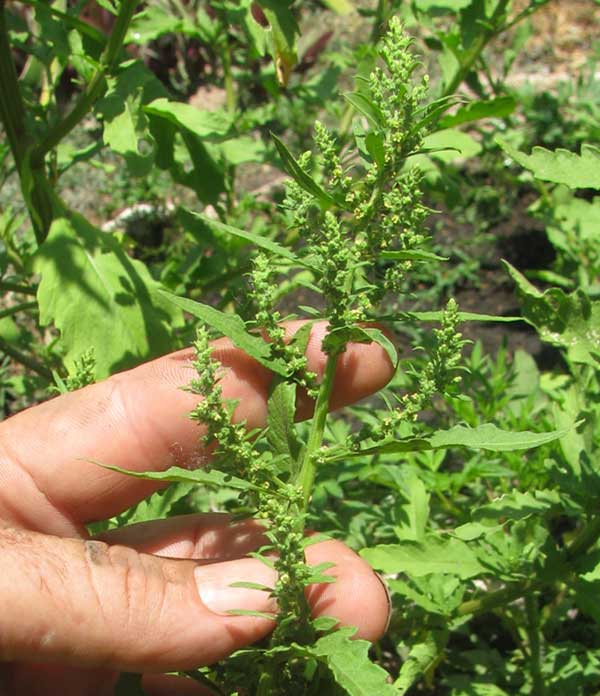
from the April 10, 2011 Newsletter issued from Hacienda Chichen Resort beside Chichén Itzá Ruins, central Yucatán, MÉXICO
EPAZOTE FLOWERING
The Epazote next to my coreopsis was so green and luxurious looking that I couldn't bear to pull it up, so each time I watered the coreopsis I watered it, too, not caring what visitors thought about my hut- area "weediness." I like my weeds, which often are more interesting and useful than the planted things. You can see a sprig of my waist-tall Epazote plants above.
Those little pagoda-like things arising from leaf axils are clusters of flowers. As with other species in the Goosefoot/Beet/Spinach Family, Epazote's flowers are tiny. You can see some individual blossoms below:
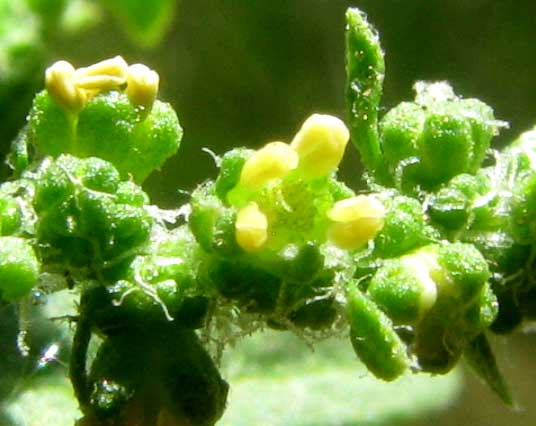
In that picture the yellow items are pollen-bearing anthers. Epazote flowers bear no corollas, just four or five green sepals surrounding the sexual parts like a bowl. The ovary with its single ovule is flattish and embedded in the calyx bottom. This configuration matures into a one-seeded fruit enclosed in a dry, persistent calyx. Such a bladdery, one-seeded fruit that doesn't split open when it's mature (it's indehiscent) is said to be a "utricle."
I've always known Epazote as CHENOPODIUM ambrosioides, of the Goosefoot/Beet/Spinach Family, the Chenopodiaceae. But now I see that gene sequencers have shifted it to a different genus and lumped the Chenopodiaceae into the Amaranth Family, the Amaranthaceae. Now Epazote is known as DYSPHANIA AMBROSIOIDES.
from the January 21, 2008 Newsletter issued from Yerba Buena near Pueblo Nuevo Solistihuacan, Chiapas, MÉXICO
EPAZOTE WORM TREATMENT
I've lost a good bit of weight since arriving here and that makes me think that maybe I have worms. In this part of the world if you want to de-worm yourself you drink Epazote tea. Epazote (eh-pa-ZO-te) is sometimes called Mexican Tea, and it grows as a weed in much of North America. When Raul, a Tzotzil-speaking friend, heard I was looking for some Epazote, the next morning he appeared at my door with a bouquet of young plants he'd just pulled from around his house, shown in my hand below:
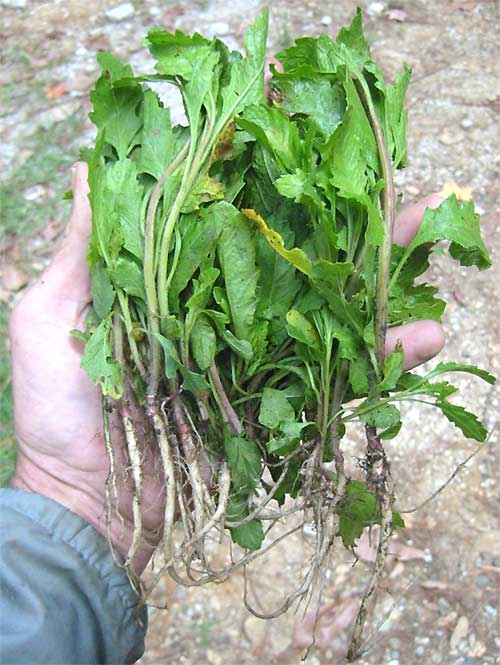
"Tomorrow morning before breakfast put these, roots and all, into boiling water and make a tea with them. Drink the tea and wait an hour or so before eating, then drink more before going to bed, and repeat the process the next day."
When you crush Epazote leaves they emit a rank, biting odor, so I'd expected the tea to be bitter. However, it tasted like Spinach, so it wasn't bad at all. In fact, Epazote is the main seasoning in cooked beans and is believed to "remove the air from them" -- it keeps down the flatulence. Here people believe that there are at least three kinds of Epazote: One that's best for beans; another that's best for worms, and; the other is in-between. Since it's such an important feature of traditional culture it's not surprising that distinct medicinal and culinary races may have been developed.
When I supped on my steaming Epazote tea it made my stomach growl and gurgle. Unfortunately I have to use a toilet where everything disappears into a black pit, so I can't confirm that the treatment worked. I'll repeat it in a few weeks, though, and maybe then I can proceed more empirically. Whatever my experience with it, it's known that Epazote contains an alkaloid called Chenopodin, which induces roundworms to release their hold on intestinal walls and pass from the body.
Maximino Martínez's classic Las Plantas Medicinales de México reports several medicinal uses of the plant beyond worm-treatment. You can make a poultice of the leaves for the chests of people suffering from asthma, it helps in digestion, using its tea as a mouthwash eases a toothache, it calms down nervousness, and can be used as a general tonic.
entry from field notes dated January 19, 2023, taken along steep, one-lane gravel road ascending forested, northeast-facing mountain slope, elevation ±2,380m (7600 ft); bedrock of Cretaceous limestone; on the south side of Pinal de Amoles, Querétaro state, MÉXICO, (N21.134°, W99.629°)
EPAZOTE DRYING ON A WALL
Atop a ridge where clouds must frequently sweep through the forest as cold fog, we came upon an old man shoveling dirt into a deep rut of the steep, rocky, one-lane road. Explaining that we were looking for interesting plants to photograph, he perked up and told us to follow him to his little house constructed of thick wooden planks, occupying the ridge's crown. Nailed onto the wall of his home was a drying collection of herbs he declared as medicine against the COVID virus. We're standing beside it below:

He called it epazote, but country people sometimes use that name for several different plants. I crushed a little between my fingers and didn't detect the distinctive epazote odor, but maybe after drying out so thoroughly it loses its odor. A closer look found a crisp, curled-up leaf, which with widely spaced teeth along the margin looked like an epazote leaf:
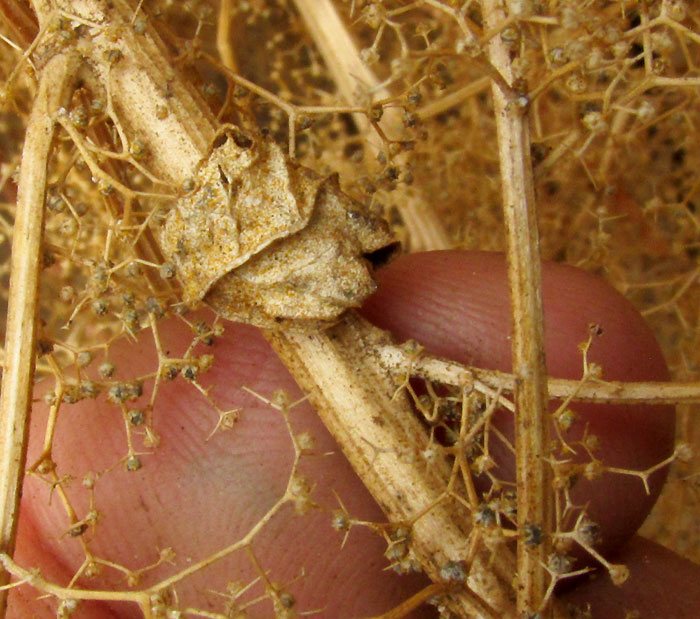
Even closer, more details matching those of epazote were seen:
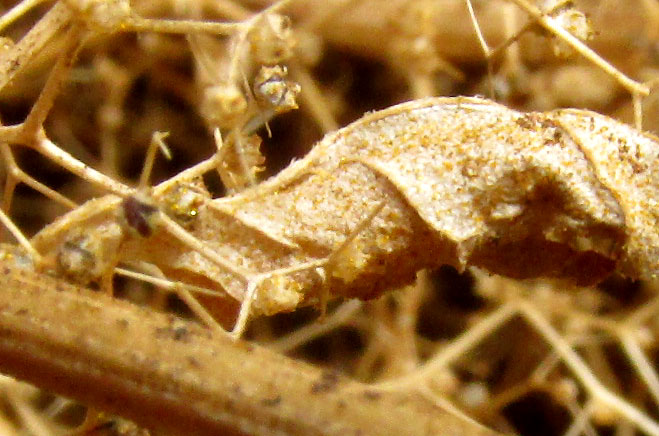
Hairs are visible along the midrib, and some very small, mature, one-seeded, achene-type fruits still within their 5-lobed perianths can be seen. This really looks like the plant best known in Mexico as epazote, Dysphania ambrosioides, and the old man knew his plant. However, in the literature I find no support for the idea that epazote is useful in treating COVID-19.
Nonetheless, in many places people appear to be drinking epazote tea to cure COVID, or at least to reduce their COVID fever. Asmaa Hazim and others, in a 2021 publication entitled "Confusion Syndrome During COVID-19: The 'Herb' That Hides the Forest?" reports on a COVID sufferer admitted to a hospital in Morroco with delirium. The patient, to bring down his fever, had been drinking "tea" from our epazote. After much testing and analysis, the researchers concluded that drinking too much of the tea probably caused the delirium. When the tea was withheld, symptoms disappeared. The writers explained that "In folk medicine, all parts (roots, leaves, flowers, bark, seeds) of D. ambrosioides are used as poultice, for baths, oral ingestion or as tea to treat influenza and other respiratory diseases as well as digestive, urogenital, vascular, and nervous disorders."
In Brazil, under the name mastruz, our epazote is so commonly used by COVID sufferers that in 2020 Sandra Sigueira and Irina Coelho, in a review of a study, published "Research investigates the potential of mastruz as a phytomedicine for use against Covid-19," in which they saw fit to issue a warning: “Here, it is worth alerting people who consume mastruz for some reason that the seeds and flowers, as well as the raw plant, can cause intoxication, as described in the scientific literature. It should also be noted that mastruz is reported as an abortifacient and should not be consumed by pregnant women.”